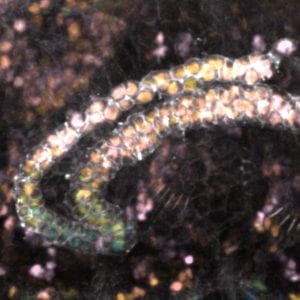The goal of the Vásquez lab is to understand the molecular rules that cells use to build and shape functional organs. Currently, we are studying the morphogenesis of the Drosophila melanogaster renal system – the Malpighian tubules. The ability to watch this organ grow and manipulate it in real time make it an ideal system for dissecting the emergent properties cells use to build complex tissue structures.
research
The Vásquez lab seeks to identify the molecular and physical mechanisms that cells use to build our organs. The goal of our lab is to dissect the emergent properties cells used to build complex higher-order tissue structures, like our organs. We take a multidisciplinary approach, using a combination of quantitative light microscopy, genetics, and biochemistry using the developing renal system of the fruit fly (Drosophila melanogaster Malpighian tubules) as an in vivo model for organogenesis.
The developing fly renal system involves the generation and extension of two pairs of tubes that fold on themselves in a stereotypic manner providing an ideal model in which to isolate the parameters that generate specific cell shapes while keeping the cells in an in vivo context. Work in our lab will leverage the known pathways and molecular mechanisms at work in studying cells at an individual basis to uncover how cells integrate these features into highly regulatable 3D tissue forms.

Current work in our lab will focus around two central questions:
[1] How do cells manage changing shape?
Over the course of 6 hours Malpighian tubules extend 4-fold in length without any cell proliferation. Throughout this process, tubule cells transition from tall columnar cells to short cuboidal cells. This transformation provides an opportunity to understand how cellular domains adapt to changing cellular dimensions in a developing organ.
[2] How do cells build tubes that fold on themselves and still function?
We are beginning to understand how tissues make prevalent epithelial motifs like folds and tubes. However, the tissue structures that make up organs are more complicated than these simple motifs. These motifs are combined to generate higher order structures with 3D folded patterns, for example a tube that loops, or a fold within the epithelial structure of a tube.
news
the lab turns 2, and gains 2 more members!✌️
We celebrated the end of fall quarter by having a potluck with the Bryant Lab. We had pizza, mac & cheese, Salvadorian quesadilla, an elaborate salad, macarons, tiramisu, and two chaotic puppies. (left puppy) Hibou Andre Cissé Konaté Vásquez Shipway (right puppy) Gareth Cheez-It Bryant The lab turns two and two new lab members! On January …
Continue reading “the lab turns 2, and gains 2 more members!✌️”
Michelle passes her General Exam & other news of note
David Baker wins the Nobel Prize – and we get to celebrate! David Baker was awarded the Nobel Prize in Chemistry, along with Demis Hassabis and John Jumper for their grounding breaking work in computational protein design. There was a celebration at the IPD! Claudia unfortunately missed said celebration, but she was flying to Baltimore …
Continue reading “Michelle passes her General Exam & other news of note”
Quick hits of summer ☀️
An exciting visit! We had our youngest, to date, scientist visitor come check out our set up. She figured out how to differentiate male and female flies from each other! Capstone achievements of the summer Michelle attended an incredibly intense workshop on AI and machine learning at the Marine Biological Laboratory (Woods Hole, MA). She’s …
people
chronological order
ALUMNI
reverse chronological order
| name | role in Vásquez lab | next stop |
| Makenna Carnahan | undergraduate researcher Winter 2024 – Fall 2024 | Suzie Pun’s lab in Bioengineering |
| Melissa Calderón Bracho | BRIGHT UP summer high school student 2023 and 2024 | senior year |
| Lily Worst | rotation student Winter 2024 | graduate student in Chip Asbury lab |













